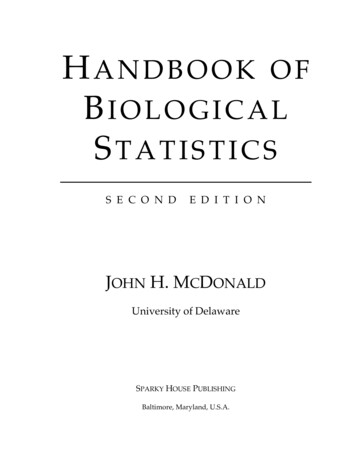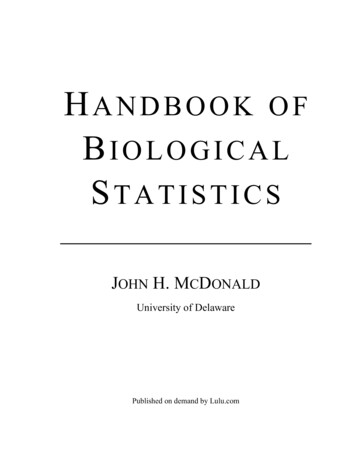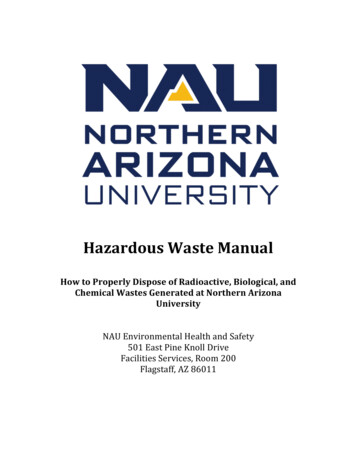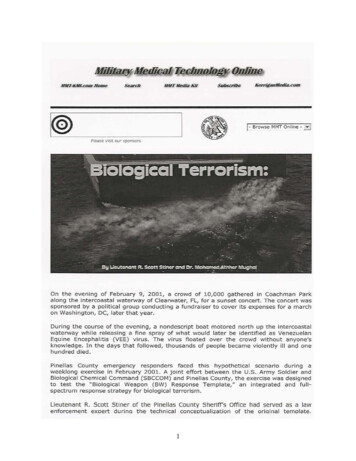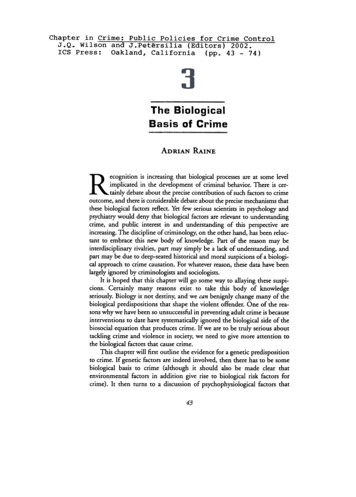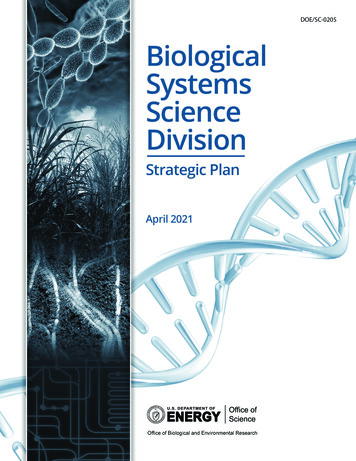
Transcription
U.S. Department of EnergyOffice of ScienceOffice of Biological and Environmental ResearchBiological Systems Science DivisionDivision DirectorTodd Andersontodd.anderson@science.doe.govGenomic SciencesBioenergy Research Centers Kent Peters kent.peters@science.doe.govShing Kwokshing.kwok@science.doe.govSystems Biology Research for BioenergyDawn Adindawn.adin@science.doe.govPlant GenomicsSustainable Bioenergy ResearchCatherine Ronningcatherine.ronning@science.doe.govShing Kwokshing.kwok@science.doe.govBiosystems DesignPablo ental Microbiome ResearchCatherine Ronningcatherine.ronning@science.doe.govBoris Wawrikboris.wawrik@science.doe.govShing Kwokshing.kwok@science.doe.govDawn Adindawn.adin@science.doe.govComputational BiologyRamana Madupuramana.madupu@science.doe.govBiomolecular Characterization and Imaging ScienceStructural Biology and ImagingUser Capabilities Amy Swain amy.swain@science.doe.govBioimaging Research Prem Srivastava prem.srivastava@science.doe.govDOE Joint Genome Institute Scientific User FacilityRamana Madupuramana.madupu@science.doe.govThis report is available at over images: Microbes in thawing permafrost, Environmental Molecular Sciences Laboratory. Switchgrass field, Great LakesBioenergy Research Center; licensed under Creative Commons CC BY-NC-ND 2.0. Rhizosphere consortia, Lawrence LivermoreNational Laboratory.Suggested citation for this report: U.S. DOE. 2021. Biological Systems Science Division Strategic Plan, DOE/SC-0205.U.S. Department of Energy Office of Science .
DOE/SC-0205Biological Systems Science DivisionStrategic PlanApril 2021Office of Biological and Environmental Research
Biological Systems Science Division Strategic PlaniiApril 2021U.S. Department of Energy Office of Biological and Environmental Research
Biological Systems Science Division Strategic PlanContentsBiological Systems Science Division By the Numbers .ivChapter 1: Fundamental Systems Biology Research for Accelerating a Burgeoning Bioeconomy.1Strategic Foundation. 1Research Portfolio. 1Sidebar: Maintaining U.S. Competitiveness in the Global Bioeconomy. 4Chapter 2: Genomic Sciences: Primary Research Efforts. 5Bioenergy Research. 5Sidebar: Bioenergy Research Centers. 6Plant Genomics. 6Microbial Conversion. 8Sustainable Bioenergy . 9Biosystems Design.10Secure Biosystems Design.12Environmental Microbiome Research.13Chapter 3: Enabling Capabilities.17Computational Biology: Integrated Computational Platforms.17Sidebar: BSSD Open- Access Cyberinfrastructure. 18Biomolecular Characterization and Imaging Science.20Sidebar: Structural Biology and Imaging Resources.21Chapter 4: User Facility Integration.25Sidebar: BER-Supported User Facilities. 26Chapter 5: Other Opportunities and Impact Multipliers.27Office of Science Graduate Student Research Program .27Early Career Research Program .27Small Business Innovation Research and Small Business Technology Transfer .27Chapter 6: Summary.29Sidebar: BSSD Research Goals.30Appendix.31References.31Image Credits.31Acronyms and Abbreviations.32U.S. Department of Energy Office of Biological and Environmental ResearchApril 2021iii
Biological Systems Science Division Strategic PlanBIOLOGICAL SYSTEMSSCIENCE DIVISION 404.8 MILLION RESEARCH BUDGETBSSD PrimaryResearch Areas 28244L443BY THE NUMBERS FY20UNIVERSITY 28%RESEARCH B IOENERGY RESEARCH(Plant Genomics, MicrobialConversion, Sustainable Bioenergy)BSSDBUDGET B IOSYSTEMS DESIGN44% NATIONALLABORATORYRESEARCHSMALL BUSINESS4% INNOVATION,TECHNOLOGYTRANSFER(Secure Biosystems Design)FACILITIES 24%FUNDING ENVIRONMENTALMICROBIOME RESEARCH4BSSD RESEARCH SPANS119531DOE NATIONALLABORATORIESACADEMIC, NONPROFIT, ANDINDUSTRIAL INSTITUTIONSSTATES, WASHINGTON, D.C.,AND PUERTO RICO237165ACTIVERESEARCHPROJECTSLED BY ACADEMIC, NONPROFIT,AND INDUSTRIAL INSTITUTIONSLED BY NATIONAL NTS21STARTUPCOMPANIESENABLING CAPABILITIES AND COMMUNITY RESOURCESCOMPUTATIONALBIOLOGY RESEARCH22PROJECTS LED BYUNIVERSITIES ANDNATIONAL LABS4RESOURCES WITH 10,800 USERS A YEARDOE JOINT GENOME INSTITUTESCIENTIFIC USER FACILITY290,492 GIGABASES SEQUENCED 2,000 CUMULATIVE PUBLICATIONSBIOIMAGING SCIENCE919NATIONAL LAB PROJECTSUNIVERSITY PROJECTS(10 QUANTUM PROJECTS)ivApril 2021STRUCTURAL BIOLOGYAND IMAGING RESOURCES10 RESOURCES AT 6 DOE USER FACILITIESKBASE300 ANALYSIS TOOLS34,564 USER NARRATIVESNATIONAL MICROBIOMEDATA COLLABORATIVE17 TB OF OMICS DATA(proteomes, metatranscriptomes,metagenomes, metabolomes, and more)U.S. Department of Energy Office of Biological and Environmental Research
Chapter 1 Fundamental Systems Biology ResearchChapter 1Fundamental Systems Biology Researchfor Accelerating a Burgeoning BioeconomyThe United States currently holds an importantinnovative edge in the burgeoning and globallycompetitive bioeconomy market. This edgeoffers significant economic benefits to technological“first movers,” but maintaining it will rely strongly ona vibrant basic science effort to understand the fundamental principles of genome biology. These principles,encoded in the genomes of plants and microbes, canadvance breakthroughs in renewable biofuels andbioproducts development, biotechnology, and understanding of key interactions among microbiomes thatshape our environment.The Biological and Environmental Research (BER)program within the U.S. Department of Energy’s(DOE) Office of Science has been at the forefront ofgenome biology research since its pioneering role ininitiating the sequencing of the human genome. Thiseffort was a milestone in genome biology that spurredan accelerating revolution in genome sequencing technology and other omics techniques that fuel today’sbiotechnology innovations. More recently, genomicscience advances have stemmed from insights gainedthrough the increasingly multidisciplinary collaborations of biologists, chemists, physicists, computer scientists, and engineers.As a major supporter of basic genome-enabledresearch, BER’s Biological Systems Science Division(BSSD) fosters scientific discovery by combiningfundamental biological research across disciplineswith enabling capabilities and world-class user facilities. This document outlines a high-level overviewof BSSD’s integrated science goals and strategies tounderstand, predict, manipulate, and design new biological processes for addressing DOE mission objectives in energy and the environment.Strategic FoundationThe Division’s strategy is rooted in broader planningefforts across DOE and seeks to align with DOE’sOverarching BSSD GoalProvide the necessary fundamental science tounderstand, predict, manipulate, and designbiological systems that underpin innovationsfor bioenergy and bioproduct production andenhance our understanding of natural, DOE- relevant environmental processes.strategic plan (U.S. DOE 2014) to enhance thenation’s energy and environmental security and to promote basic research in the environmental and biological sciences in support of DOE’s mission. Other inputshelp further shape the Division’s strategy (see Fig. 1.1,p. 2). BSSD receives stakeholder input through guidance from the Biological and Environmental ResearchAdvisory Committee (BERAC), which publishesperiodic reports on emerging research needs (BERAC2017). BSSD also gathers feedback during workshopson mission- relevant topics. For example, recent workshops have sought to strengthen the Division’s portfolio by exploring ways in which gene function may bebetter understood across diverse plant and microbialtaxa (U.S. DOE 2019a) and examining how genomicinformation may aid in the synthesis and design ofnew biomaterials (U.S. DOE 2019b). The Division’sstrategy is further informed via a tight integrationof program management activities with its researchportfolio. In addition, BSSD leverages synergies acrossDOE and at other federal agencies to strengthen andenhance its strategic outlook, fill research gaps, andbroaden the impact of its research community.Research PortfolioBSSD’s overall research goal is to provide the necessaryfundamental science to understand, predict, manipulate, and design biological systems that underpininnovations for bioenergy and bioproduct production and to enhance our understanding of natural,U.S. Department of Energy Office of Biological and Environmental ResearchApril 20211
Biological Systems Science Division Strategic PlanFig. 1.1. Multiple Mechanisms Shape BSSD’s Strategy. BSSD relies on stakeholders and the research community to inform itsvision, with these inputs all feeding back into each other in a dynamic interplay that helps to prioritize the research portfolio.DOE- relevant environmental processes. At the core ofthis effort is BSSD’s Genomic Science program, whichsupports basic research to answer fundamental biological questions including:1. W hat information is encoded in a genomesequence, and how does this information directthe functional characteristics of cells, organisms,and whole biological systems?2. H ow do interactions among cells regulate thefunctional behavior of living systems, and howcan these interactions be understood dynamicallyand predictively?3. H ow do plants, microbes, and communities oforganisms adapt and respond to changing environmental conditions (e.g., temperature, water2April 2021and nutrient availability, and ecological interactions), and how can their behavior be manipulatedtoward desired outcomes?4. W hat organizing biological principles need to beunderstood to facilitate the design and engineeringof new biological systems for beneficial purposes?The Genomic Science program encompasses a broadrange of research areas including bioenergy research,genome biology and sustainability of bioenergy crops,biosystems design or synthetic biology, environmental microbiomes, and computational biology andcyberinfrastructure for genomic science. These areasrepresent distinct pillars of the program, but eachone is also tightly integrated with other portfolio elements, such as enabling capabilities and user facilities,through targeted, crosscutting funding opportunitiesU.S. Department of Energy Office of Biological and Environmental Research
Chapter 1 Fundamental Systems Biology ResearchFig. 1.2. Biological Systems Science Division Portfolio. BSSD’s three primary research areas in genomic sciences—BioenergyResearch, Biosystems Design, and Environmental Microbiome Research—are supported by a suite of user facilities andenabling capabilities in computational biology and biomolecular characterization and imaging science.and DOE national laboratory projects. Among theseintersecting themes are three major components:Bioenergy Research, Biosystems Design, and Environmental Microbiome Research (see Fig. 1.2, this page).Bioenergy Research seeks to couple a basic understanding of plants and their associated microbial communities to advance the sustainable production of biofuelsand bioproducts from plant biomass. Dedicated cropsgrown on marginal lands for conversion into renewablesources of fuels or valuable chemicals and bioproductsrepresent a key strategy to reduce the nation’s relianceon fossil resources for the production of these criticalmaterials. Because fossil resources are ultimately finiteand subject to economic and geopolitical uncertainty,renewable sources for the fuels and products that support modern society are of keen interest to DOE, andthey are a long-term strategic need for the nation anda strong bioeconomy (see sidebar, Maintaining U.S.Competitiveness in the Global Bioeconomy, p. 4).BSSD’s Biosystems Design efforts focus on understanding fundamental biological principles to enablethe design and engineering of plants and microbeswith new or enhanced traits beneficial for energyor environmental applications. Rapid advances ingenome- enabled discovery, design, and engineering areleading to exciting new possibilities in biotechnologyto create new biosynthetic processes by drawing fromthe gene diversity found in nature and accumulatedU.S. Department of Energy Office of Biological and Environmental ResearchApril 20213
Biological Systems Science Division Strategic PlanMaintaining U.S. Competitivenessin the Global BioeconomyAdvances in fundamental biological research andenabling technologies have sped the creation ofcommercial opportunities in fields spanning fromagriculture to pharmaceuticals to energy, producing major economic and societal benefits. Safeguarding the Bioeconomy, a report by the NationalAcademies of Sciences, Engineering, and Medicine(2020), estimates the value of the U.S. bioeconomy at nearly 1 trillion, or 5.1% of gross domestic product. The report defines the bioeconomy as“economic activity that is driven by research andinnovation in the life sciences and biotechnology,and that is enabled by technological advances inengineering and in computing and informationsciences.” Producing breakthrough scientificresults that continue to fuel the bioeconomyhinges on sustained investment in basic scienceresearch and developing and attracting a skilledworkforce, particularly in life science applicationsof computational and information science.understanding of biological processes. This area ofresearch is both fascinating in terms of its possibilities and challenging as the global pace of research isaccelerating rapidly. The Division is committed tobuilding on its established presence in the field of basicgenome-enabled research and using newfound knowledge to explore possibilities in genome design.BSSD’s Environmental Microbiome Research seeks tounderstand how microbes and plants interact in theirnatural environment. Microorganisms and plants haveevolved in the context of complex microbiomes andenvironmental change. Discovering how microbesinteract within communities and adapt to environmental perturbations and long-term change is essential forunderstanding the many bioenergy and environmentalprocesses relevant to DOE. Of particular interest is theability to predict interactions among organisms based4April 2021on the information encoded in their genomes, as well asthe dynamic expression of their activities in associationwith one another and their environment. Gaining a predictive and functional understanding of microbiomeswill enable better understanding of microbial ecology,plant-microbe interactions, and the cycling of elementsin terrestrial environments.These primary Genomic Science program elementsare supported by BSSD’s efforts to develop enablingcapabilities. In particular, BSSD will build integrative,open-access computational platforms to combine datasets with analysis applications in a “virtual laboratory”concept to accelerate collaborative, multidisciplinaryscience. As demonstrated during the COVID-19 pandemic, the integrated, high-performance computing- based analysis of molecular, structural, imaging,multiomic, cellular, and multicellular datasets canefficiently guide researchers toward potential solutionsto otherwise intractable problems (e.g., possible therapeutic solutions for COVID-19).Going forward, BSSD will work to increasinglyintegrate data science techniques into its researchapproach to support DOE mission areas. Early effortsto create greater virtual integration of data and analytical capabilities are underway across the DOE JointGenome Institute ( JGI), Environmental MolecularSciences Laboratory (EMSL), DOE Systems BiologyKnowledgebase (KBase), and new National Microbiome Data Collaborative (NMDC). Re-envisioning theway that BER uses data to accelerate genome-enabledscience could revolutionize how science is conducted.BSSD will pursue this virtual laboratory concept andseek partnerships within DOE and other agencies torealize this vision.Outlined in the following sections are the current goalsand objectives within the Division’s major researchefforts. These efforts are complemented by a suite ofenabling capabilities and technologies available atDOE national scientific user facilities.U.S. Department of Energy Office of Biological and Environmental Research
Chapter 2 Genomic Sciences: Primary Research EffortsChapter 2Genomic Sciences: Primary Research EffortsBSSD-supported research at universities andnational laboratories is providing systems-levelunderstanding of plants, microbes, and theircommunities. This multidisciplinary portfolio—broadly grouped under Bioenergy Research, Biosystems Design, and Environmental MicrobiomeResearch—pursues innovative science underpinningadvances in sustainable biofuels and bioproducts; thedesign, modification, and optimization of plants andmicrobes for beneficial purposes; and next-generationtechnologies for systems biology research.Bioenergy Research G oal: Provide the basic science needed to convertrenewable biomass to a range of fuels, chemicals,and other bioproducts in support of a burgeoningbioeconomy.Today’s liquid fuels and many of the chemical productsand materials that support modern society are primarily derived from petroleum and other fossil resources.Producing fuels, chemicals, and bioproducts (includingmaterials) from renewable plant biomass could reduceour dependence on fossil resources and pave the waytoward a more sustainable bioeconomy (see Fig. 2.1,this page).BSSD Bioenergy Research efforts seek to provide thefundamental science needed to underpin the production, breakdown, conversion, and use of plant biomassas a renewable alternative to petroleum. The scope ofthis research includes gaining a basic understanding ofplant and microbial genomics for dedicated crop development and conversion of plant biomass into productsand pursuing fundamental insights into the sustainability of bioenergy crop production. Many of theFig. 2.1. Biofuel Feedstocks. Lowland switchgrass is ready for harvesting from a common garden in Overton, Texas. [Courtesy University of Texas–Austin]U.S. Department of Energy Office of Biological and Environmental ResearchApril 20215
Biological Systems Science Division Strategic PlanBioenergy Research Centersgenomicscience.energy.gov/centers/DOE’s Bioenergy Research Centers take an integratedresearch approach that aims to improve and scaleadvanced biofuel and bioproduct production processes.Important goals are the sustainable production of feedstocks, their deconstruction and separation, and theirconversion to next-generation biofuels and bioproducts.Center for Advanced Bioenergy andBioproducts Innovation (CABBI)cabbi.bioUniversity of Illinois at Urbana-ChampaignCenter for Bioenergy Innovation (CBI)cbi.ornl.govOak Ridge National LaboratoryGreat Lakes Bioenergy Research Center (GLBRC)glbrc.orgUniversity of Wisconsin–MadisonJoint BioEnergy Institute (JBEI)jbei.orgLawrence Berkeley National LaboratoryDivision’s recent efforts have been performed withinthe four DOE Bioenergy Research Centers (BRCs).These large, interdisciplinary BRC teams have providedkey basic science insights needed to spur broader development of biofuels and bioproducts from lignocellulosic plant biomass (see sidebar, Bioenergy ResearchCenters, this page). Continued research within BSSDwill seek to expand this body of knowledge to extendthe range of biofuels and bioproducts that can be produced from biomass feedstocks.The Division plans to maintain investments in theBioenergy Research program’s core strengths related toplant genomics and the development of dedicated bioenergy crops, deconstruction of plant biomass, microbial conversion of biomass to fuels and products, andthe sustainability of bioenergy crop production. BSSDwill support these efforts through awards to large, integrative teams such as the BRCs, smaller team researchprojects, and single investigators. Additionally, the6April 2021Cellulose Microfibrils. The nanostructure of a nativeplant cell wall imaged using atomic force microscopy(AFM) shows layers of interwoven cellulose microfibrils. Scientists used AFM to study the dynamicstructure of plant cell walls from fresh plant and lignocellulosic biomass during enzymatic deconstruction.[Courtesy Shi-You Ding, Michigan State University]Division will seek to encourage greater integrationamong the current BRCs toward common goals, objectives, and milestones that chart a path for the nextdecade of bioenergy research.Plant Genomics S ubgoal: Gain a genome-level understanding of plantmetabolism, physiology, and growth to develop newbioenergy feedstocks with traits tailored for bioenergyand bioproduct production.Realizing the potential of lignocellulosic biomass asa source of renewable energy and biobased productsrequires the development of high-yielding crops andtrees or nonfood oil seed crops that efficiently useresources and minimally disrupt existing food and fibermarkets. Additionally, bioenergy feedstock productionneeds to contend with changing climatic conditionsand ensuing environmental impacts (e.g., drought,U.S. Department of Energy Office of Biological and Environmental Research
Chapter 2 Genomic Sciences: Primary Research Effortsabout 40% of all genes in any sequenced plant genomeremains unknown.Fig. 2.2. Plant Systems Biology. Rebecca Dewhirst, a postdoctoral researcher at Lawrence Berkeley National Laboratory (LBNL), studies the leaf water potential of poplar trees inresponse to an experimental drought. [Courtesy LBNL]temperature extremes, and increased pathogen pressure), which may threaten the productivity of all agricultural crops (see Fig. 2.2, this page).Plant research faces unique challenges in biologicaland genetic diversity, such as teasing out the frequentsegmental and whole genome duplications that oftenresult in large gene families and subfunctionalizationof their member genes. These plant genome featuresadd layers of complexity to the already intricate natureof eukaryotic gene expression and regulatory networks. While this complexity has increased plants’adaptability to diverse environments, it also poseschallenges in identifying and characterizing the functional roles of genes responsible for plant phenotypes.Furthermore, researchers estimate that the function ofThe Division recognizes that gene function determination has not kept pace with omics data acquisition andthat this incongruence represents an ascending challenge for the research community. BSSD will thereforeseek to support research into more efficient, higher- throughput, multidisciplinary methods for generatingexperimental evidence of gene function. This effort willinvolve integrating plant physiological experimentationwith high-throughput phenotyping and novel computational approaches. Supported research will leveragethe unique infrastructure offered by BER’s user facilities( JGI and EMSL), as well as DOE’s light and neutronsources, and research goals will tightly align with thoseof the computational biology portfolio. BSSD strives toachieve a better understanding of whole living systemsby elucidating the properties of individual componentswithin their molecular, cellular, and organismal contexts, thereby gaining the ability to predict bioenergyfeedstock behavior under fluctuating and sometimesextreme conditions. A fuller picture of the role playedby an organism’s genetic background should allowresearchers to accurately predict phenotype from genotype and enable more rapid scientific advancement.In this context, current objectives for BSSD plantgenomics research are to: iscover and functionally characterize key plantDgenes and alleles that influence yield and qualitytraits and/or confer adaptability or resilience to arange of environmental conditions and change inbiomass crops (e.g., switchgrass, energy sorghum,poplar, and Miscanthus spp.) and nonfood oilseedcrops (e.g., Camelina spp. and pennycress). evelop innovative approaches for understandDing the distinct functions of genes, proteins,and metabolites of the multiple cell types foundwithin plant organs. omprehensively investigate genetic and epiCgenetic regulatory mechanisms and developmethods to discern regulatory differences amonggene family members.U.S. Department of Energy Office of Biological and Environmental ResearchApril 20217
Biological Systems Science Division Strategic Plan evelop comparative approaches to enhanceDknowledge of the structure, function, and organization of plant genomes and to identify reducedsets of candidate genes for detailed functionalcharacterization across related species. etermine high-resolution molecular structuresDof proteins/enzymes and assemblies to identifyand prioritize structural features affecting theirfunction and specificity and integrate thesestructures with computational modeling to identify and prioritize structural features affectingtheir function and specificity. issect complex phenotypes (e.g., yield as well asDwater and nutrient use) into genetic componentsand use natural variants, mutants, gene editing,and transgenes to characterize and validate genefunction to understand impact on phenotype. evelop and validate methods to map quantiDtative associations within clades using synteny,homology, cross-species co-expression networks, and other such analyses. xamine the complex interactions between bioEenergy feedstock plants and their environment,as well as the influence of these interactionson plant growth and development, expressionof bioenergy- relevant traits, and adaptation tochanging environments. evelop new and fundamental knowledge ofDbiomass deconstruction processes to convert abroader range of biomass types into a range ofprecursors that are readily convertible into bio fuels and bioproducts. I ncrease degradability and expand usability ofbiomass components (e.g., hemicellulose andlignin monomers).Lignocellulosic biomass is an abundant and renewablenatural resource. Converting it to fuels and bioproductsrepresents an important research frontier in the searchfor sustainable alternatives to nonrenewable fossilfuels. Importantly, lignocellulosic biomass crops do notnecessarily compete against food c
Strategic Foundation The Division's strategy is rooted in broader planning efforts across DOE and seeks to align with DOE's strategic plan (U.S. DOE 2014) to enhance the nation's energy and environmental security and to pro-mote basic research in the environmental and biologi-cal sciences in support of DOE's mission. Other inputs


